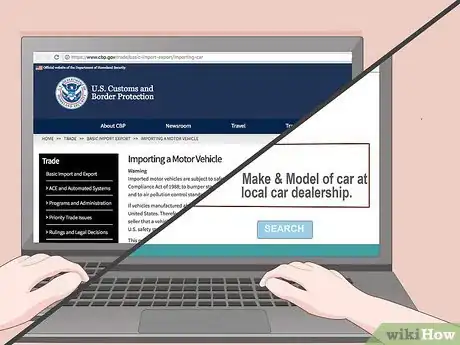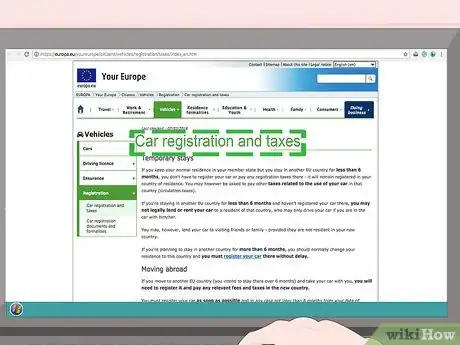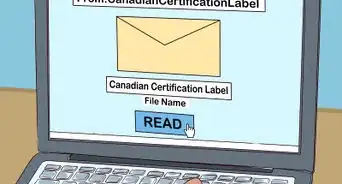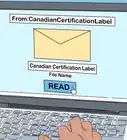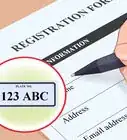This article was co-authored by wikiHow Staff. Our trained team of editors and researchers validate articles for accuracy and comprehensiveness. wikiHow's Content Management Team carefully monitors the work from our editorial staff to ensure that each article is backed by trusted research and meets our high quality standards.
This article has been viewed 28,268 times.
Learn more...
If you’re planning to buy or already own a car in Germany and want to import it to use in your country, you can do so with a few simple considerations and steps. First, you will want to determine if the car is eligible to be driven in your country. Working with a registered importer can help you complete necessary paperwork and customs requirements to get your car home as quickly as possible.
Steps
Taking Preliminary Steps
-
1Find out if the car meets your country’s compliance regulations. Many countries have regulations about types of cars that can be driven within that country. For instance, in the U.S., any car driven on U.S. roads must either be originally marketed for sale in the U.S., or modified once it is imported to meet compliance regulations.[1]
- Most cars in the U.S. and Canada that are manufactured abroad are specifically manufactured to meet U.S./Canadian regulations. Be wary of any private seller who claims that a car meets relevant standards or can be easily brought into compliance.[2]
- Sometimes people decide that the costs of modifying a car that is not originally marketed in their country are too high, and they look for another type of car to buy instead.
- Search for the make and model of the car at your local car dealerships to find out if the car is marketed in your country.
-
2Register the car if you’re within the EU. If you bought or are planning to buy a car in Germany and bring it home to another country within the European Union, you’ll need to register the car in your country and pay the appropriate taxes. You must register the car in your country within 6 months of your arrival to avoid penalties.[3]
- If you’re staying in an EU country temporarily, or for less than 6 months, you do not have to register a car that was bought in Germany or any other EU country.
- Visit https://europa.eu/youreurope/citizens/vehicles/registration/taxes/index_en.htm for more information about buying, selling, and registering cars within the EU.
Advertisement -
3Complete the necessary paperwork. Cars that do not automatically meet the compliance regulations or safety standards of your country may need to have a specific declaration form filed on them before they can be imported on a temporary basis. In the U.S., cars not manufactured to meet U.S. or Canadian safety standards must have an HS-7 declaration form filed for temporary importation.[4]
- Temporary importation is dependent upon the car’s eventual modification to meet federal safety standards within a certain amount of time. Not modifying the car can lead to its eventual seizure.
- Appropriate paperwork needed for importing nonconforming cars into the U.S. can be found at the National Highway Traffic Safety Administration website at https://icsw.nhtsa.gov/cars/rules/import/.
- For paperwork on importing a car to a country outside the U.S., search your country’s national or federal transportation website for rules on car importation.
-
4Work with a registered importer for the best results. A registered car importer can help you determine if the car you’re interested in importing meets compliance and safety regulations, and can help you fill out any necessary paperwork. These importers are also licensed to help you modify certain nonconforming cars according to regulations.
- Visit https://icsw.nhtsa.gov/cars/rules/import/ for a list of registered car importers in the U.S. by state.
Getting the Car into Your Country
-
1Find a reliable shipper. Once you have determined that the car either meets compliance regulations or that you will modify it to meet them, you’re ready to have your car shipped to you. Research a few shipping companies that ship internationally, and then do a background check on the company’s licensing, insurance record, and complaint history.[5]
- Consumers in the U.S. can check the quality of a shipping company through the Federal Motor Carrier Safety Administration.
- For consumers outside the U.S., contact your federal department of transportation or vehicle safety about shipping cars internationally.
-
2Buy insurance for protection. Damage can occur in any shipping process, so you’ll want to have protection in place if the damage occurs during shipment. Most car shipping companies offer insurance covering up to $50,000 - $1,000,000 in damages, but be sure to read the fine print when determining what the insurance package offers.[6]
-
3File the car with customs. Customs and border protection agencies require entries to be filed on vehicles at the time of their arrival. You can begin the customs entry process ahead of time by working with a registered importer or discussing the international shipment process with your shipper.[7]
- If you have customs paperwork started when the car arrives at its port, a border officer will promptly help you to complete the process.
- Not having customs paperwork prepared ahead of time can lead to delays in taking your car home. In the U.S., you will not be able to register your car without a copy of the CBP (Customs Border Protection) entry form.
- Customs regulations are not a concern if you are an EU citizen importing a car from Germany to another country within the EU.
-
4Pay the necessary fees and taxes. Different countries have different tax regulations for the importation of international vehicles. Find out your country’s imported car tax requirements by searching your country’s national transportation or vehicle safety websites.[8]
- Visit https://www.gov.uk/importing-vehicles-into-the-uk for tax information on importing cars to the UK.
- For tax and registration information for importing cars to Belgium, visit https://www.angloinfo.com/how-to/belgium/transport/vehicle-ownership/importing-an-eu-vehicle.
- Visit https://infrastructure.gov.au/vehicles/imports/ for information on related taxes for importing cars to Australia.
-
5Inspect the car upon its arrival. A reliable shipping company will usually check the car for scratches and dents, and record this information, prior to starting shipment. When the car arrives, walk around it and look carefully to make sure you agree with the shipper’s report.[9]
- If you disagree with the shipper’s report and find extra damage on your car, address your concerns with them immediately and then file a claim with the shipping insurance company.
- If there is damage on the car in the shipper’s report that you were unaware of at the time you purchased the car, you will need to deal directly with the seller or dealer in Germany regarding this damage.
-
6Register your car locally. To drive your imported car, you will need to have it registered according to your state’s regulations. Attempting to drive an unregistered car can lead to having it taken from you by authorities. Search your state’s department of motor vehicles website for more information on how to register a car in your state.[10]
References
- ↑ https://help.cbp.gov/app/answers/detail/a_id/218/~/requirements-for-importing-a-vehicle-%2F-vehicle-parts
- ↑ https://www.cbp.gov/trade/basic-import-export/importing-car
- ↑ https://europa.eu/youreurope/citizens/vehicles/registration/taxes/index_en.htm
- ↑ https://help.cbp.gov/app/answers/detail/a_id/218/~/requirements-for-importing-a-vehicle-%2F-vehicle-parts
- ↑ https://cars.usnews.com/cars-trucks/how-to-ship-a-car
- ↑ https://cars.usnews.com/cars-trucks/how-to-ship-a-car
- ↑ https://help.cbp.gov/app/answers/detail/a_id/218/~/requirements-for-importing-a-vehicle-%2F-vehicle-parts
- ↑ https://help.cbp.gov/app/answers/detail/a_id/218/~/requirements-for-importing-a-vehicle-%2F-vehicle-parts
- ↑ https://cars.usnews.com/cars-trucks/how-to-ship-a-car
